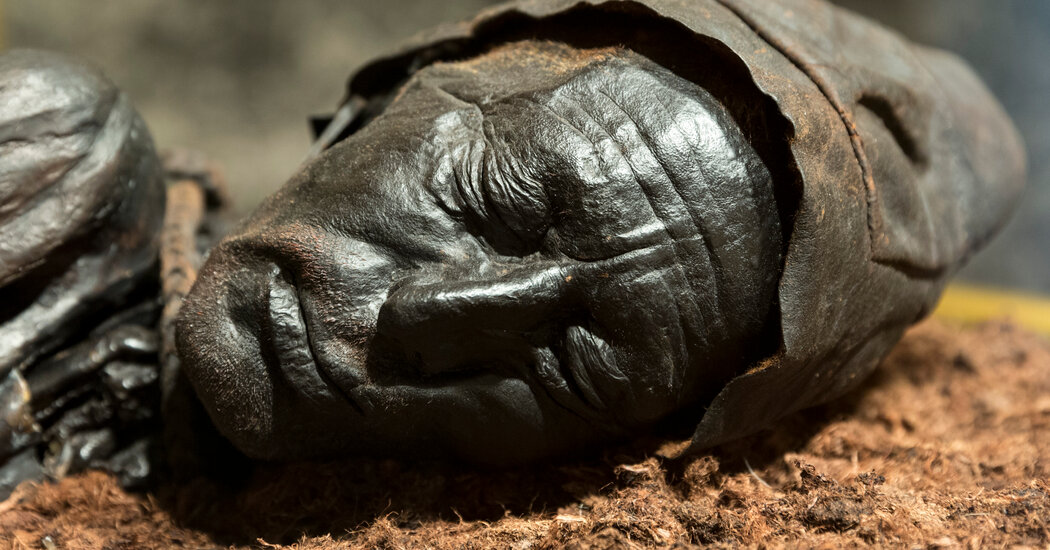

Bog-mummified people are mainly found in raised bogs — discrete, dome-shaped masses of peat that typically form in lowland landscapes and reach depths of 30 feet or more. (Blanket bogs are generally shallower and spread out widely over wet or upland areas.)
The first recorded body emerged from Schalkholz Fen in Holstein, Germany, in 1640. Since then, the cold-weather swamps of northern Europe have yielded such regional curiosities as Windeby Girl, Haraldskjaer Woman, Lindow Man, Clonycavan Man, Old Croghan Man and Koelbjerg Man. The bones of Koelbjerg Man, recovered in 1941 on the Danish island of Funen, date to 8000 B.C. Seamus Heaney’s melancholy “Bog Poems” include a lament for Grauballe Man, whose throat was slit in the third century B.C.:
The cured wound
opens inwards to a dark
elderberry place.
Of the 57 bog people whose cause of death could be determined in Dr. van Beek’s study, at least 45 met violent ends, and quite a few were bludgeoned or suffered mutilation and dismemberment before they died. Tollund Man, dating to the fifth century B.C. and dredged from a Danish peat bog in 1950, was hanged. Bone arrowheads were found embedded in the skull and sternum of Porsmose Man, recovered from peat elsewhere in Denmark. Seven victims appear to have been slain by several means, a practice that scholars call overkilling. Almost all of the overkills in Dr. van Beek’s study occurred from 400 B.C. to 400 A.D.
While most sites held just a single deceased person, some were used repeatedly, with one Danish bog, Alken Enge, estimated to hold the disarticulated remains of more than 380 ancient warriors killed in a brutal conflict and left in open water. The bones, exclusively male and predominantly adult, date to early in the first century A.D., when Germanic tribes engaged in intratribal warfare. Researchers believe that the dead were cleared from the battlefield and dumped into the bog with their weapons and personal ornaments.
This would have been one of the lesser indignities that befell bog people. Many were hastily extracted or improperly conserved; in the Netherlands of the late 18th century, four bog corpses were even ground into mumia — mummy powder — and sold as remedies.
A fundamental question about these Iron Age victims is why. Were they murdered? Executed? Sacrificed to the gods, perhaps as fertility offerings? Miranda Aldhouse-Green, emeritus professor of archaeology at Cardiff University and author of “Bog Bodies Uncovered,” has argued that ritual sacrifices may have been undertaken at times of crisis in a community: famine, extreme weather, war threats, the perceived need to kill foreign hostages.
24World Media does not take any responsibility of the information you see on this page. The content this page contains is from independent third-party content provider. If you have any concerns regarding the content, please free to write us here: contact@24worldmedia.com

Common Mistakes When Using Athletic Field Tarps

High-Performance Diesel Truck Upgrades You Should Consider

Warehouse Optimization Tips To Improve Performance

Fire Hazards in Daily Life: The Most Common Ignition Sources

Yellowstone’s Wolves: A Debate Over Their Role in the Park’s Ecosystem

Earth Day 2024: A Look at 3 Places Adapting Quickly to Fight Climate Change

Millions of Girls in Africa Will Miss HPV Shots After Merck Production Problem

This Lava Tube in Saudi Arabia Has Been a Human Refuge for 7,000 Years

Four Wild Ways to Save the Koala (That Just Might Work)

National Academy Asks Court to Strip Sackler Name From Endowment

Ways Industrial Copper Helps Energy Production

The Ins and Out of Industrial Conveyor Belts